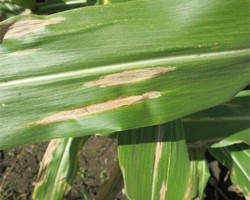Northern Corn Leaf Blight in Sweet Corn
Julie Kikkert, Team Leader, Extension Vegetable Specialist
Cornell Vegetable Program
August 8, 2016

The fungus Exerohilum turcicum that causes NCLB survives as spores or mycelia on corn debris over the winter. The inoculum can be splashed onto the current corn crop or can arrive by wind. The spores can be moved long distances by wind. Early infections come from within the field and are more damaging. As the season progresses and the numbers of spores in the air increases, all fields become susceptible. Infection is favored by leaf wetness and cool weather (64-81 F) as typically occurs later in the growing season.
Lesions of NCLB begin as grayish green and become tan as they mature. The slender oblong shape, with tapered ends, gives them a cigar or boat-shaped appearance. Lesions range from 1 to 6 inches in length and may coalesce to cover the entire leaf. Spores are produced on the underside of the leaves, and appear as dusty green fuzz.
Resistant varieties and cultural practices to reduce inoculum and disease risk are the best practices. Fields should be scouted whorl through tassel. There is a scouting video for field corn developed by the NYS IPM Program (see list of resources below). Several fungicides are labeled and a listing can be found in the Cornell Vegetable Guidelines.
ADDITIONAL RESOURCES
NYS IPM Scouting video:
Cornell NCLB fact sheet includes lists of fungicides and their relative effectiveness. Note: check labels for sweet corn.
Vegetable MD Online, Sweet Corn Diseases

Upcoming Events
2025 Potato Advisory Meeting
December 16, 2025
Canandaigua, NY
Come hear the latest on insect pest control and fertility management in potatoes from Cornell University experts. Potato variety trial updates will be shared too. After lunch will be the Empire State Potato Grower's Meeting. 1.5 DEC credits in 10, 1a, and 23.


































